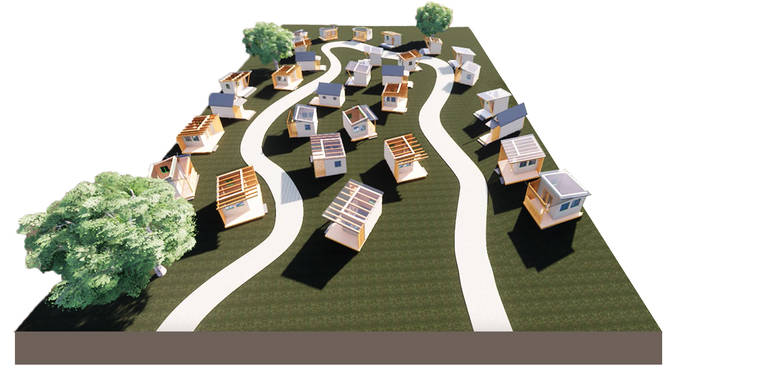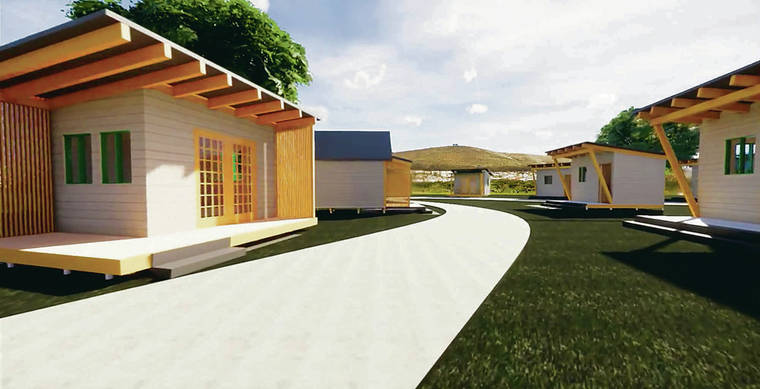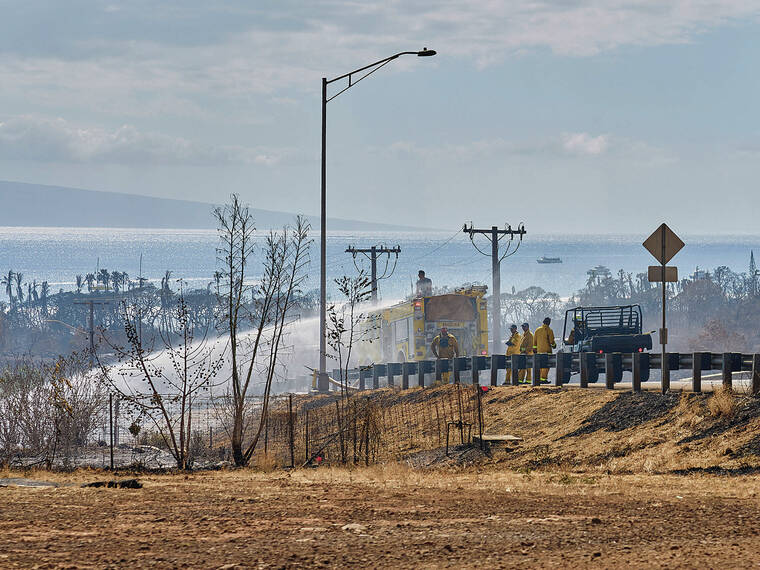First kauhale homeless tiny homes going up next month in Kalaeloa


RENDERING COURTESY JOSH GREEN
A rendering of the kauhale homes in Kalaeloa show how the two acres of Hawaii Housing Authority land will be used for military veterans who are homeless.

RENDERING COURTESY JOSH GREEN
Concept art shows what the Kalaeloha homes will look like.



The first 10 tiny homes aimed at housing homeless military veterans are scheduled to go up next month in Kalaeloa as part of a new, wider approach to quickly develop permanent housing communities for homeless adults who have been living the longest on Oahu’s streets.
“It’s meant to help people who have been chronically homeless,” said Lt. Gov. Josh Green. “Sweeps are not necessarily helping.”
By March, Green hopes to see the first “kauhale” — it means “village” — complete. It’s planned to accommodate a total of 35 to 39 tiny homes of 100-square feet or so on two acres of Hawaiian Housing Authority land next to the US Vets homeless organization, which is offering to provide support to its new neighbors.
If the concept works — and Green is convinced it will — he then hopes to expand the idea to four more Oahu locations in 2020 and then onto the neighbor islands in 2021.
The idea was borrowed from a similar project in Austin, Texas. In Hawaii, it would mean transferring unused state land to the Hawaii Housing Authority and then bringing together builders and donors to quickly create communities of tiny homes for chronically homeless adults from specific demographics, while providing help for their underlying issues.
“This is permanent housing,” Green said. “We can do an efficient, low-impact kauhale that does not break the bank and gets people housed.”
Don't miss out on what's happening!
Stay in touch with breaking news, as it happens, conveniently in your email inbox. It's FREE!
The idea to put the land under the authorization of the Hawaii Housing Authority came from the state’s homeless coordinator, Scott Morishige, who told Green that the authority has a homeless component “as part of its mission,” Green said.
Green hopes subsequent kauhale will be aimed at specific populations of chronically homeless adults next year on:
>> A half-acre of Department of Hawaiian Home Lands land next to the Waianae Coast Comprehensive Center that would house 16 DHHL beneficiaries.
>> Six acres of Board of Land and Natural Resources land next to Waimanalo Beach Park for 40 tiny homes for homeless people from Waimanalo.
>> 1.3 acres of state land on Nimitz Highway across from Middle Street for 90 tiny homes for homeless people from the area.
>> A parcel of Hawaii State Hospital land in Kaneohe to build 12 tiny homes for newly released patients at risk of becoming homeless.
Asked which kauhale would be built next after the initial community in Kalaeloa, Green said: “All of them simultaneously.”
The concept was inspired by a September trip to the Community First! village in Austin that houses over 200 formerly homeless tenants and is planning an even bigger expansion on 51 acres of land.
Community First! also includes revenue-generating operations for its tenants that Green would like to replicate in Hawaii, including an art studio where residents create art, jewelry and woodworking that is sold in the community’s gift shop; an auto shop that can issue safety checks; and an outdoor movie theater that is open to the public for “Movies Under the Stars,” where neighbors pay admission and buy concessions and get to know the residents of Community First!, Green said.
In Hawaii, Green would expect that business operations would generate enough money to keep residents employed.
In Texas, he said, “We saw a community that can be built so people want to use it.”
Perhaps more importantly, the Austin community saw a 60% reduction in drug use and an 82% retention rate.
Green, a Hawaii island emergency room physician, hopes that the kauhale concept cuts down on expensive and time-consuming interactions between homeless people and law enforcement, jails, the court system, ambulance rides and emergency room visits.
“The goal is to save taxpayers a ton of money by decreasing high-cost utilization,” he said.
The Austin trip was organized by Nani Medeiros, executive director of Home Aid Hawaii, a non-profit organization created by Oahu’s builders and developers “to do our part to fight homelessness,” Medeiros said.
“I’ve just never really seen people come together like this,” Medeiros said. “It’s fantastic and we want to replicate it.”
So far 10 Home Aid Hawaii board members — and even people unaffiliated with Home Aid Hawaii — have offered to pay for construction of $17,000 to $20,000 per unit, or build tiny homes outright for the first kauhale in Kalaeloa.
They include Stanford Carr (two homes); Castle and Cooke Hawaii (two homes); Albert C. Kobayashi Inc.; Isle Communities; Mockingbird Tiny Homes from Hawaii island; Tiny home builder Jake Johnson; Tiny Green Homes; and EAH Housing and Unlimited Construction, which are teaming up on one home.
There are four floor plans of approximately 100 square feet each, plus an additional lanai of 32 to 48 square feet, Medeiros said.
Residents would be expected to pay $200 to $250 in monthly rent.
“For the building industry, it’s a very easy way to give back,” Medeiros said. “We’re asking them what they’re experts at.”
Medeiros said it was easy to get the initial volunteers involved because “it’s a brand new approach and it’s permanent housing. We’re trying to build a community.”
The Kalaeloa site sits on flat, grass land and has power, water and sewer capacity. Volunteers have already done prep work on the site and tested it for lead and asbestos and other hazards, Medeiros said.
But more work needs to be done on an existing building of over 2,000 square feet that’s intended to be used for bathrooms, a kitchen and possibly a laundry, Medeiros said.
Homeless people who were squatting inside previously set a portion of the building on fire. So decisions need to be made on whether to renovate the entire building or build around the damaged portion.
“We want to do it quickly, we want to do it efficiently,” Medeiros said.
Just for the Kalaeloa project, Green said he went before the Hawaii Housing Authority board “and made a humble request for 24 units.”
Green said the first kauhale has attracted “partners galore,” including support from the popular HieHie mobile hygiene trailer that helps connect homeless people to services through the offer of a hot shower and a clean toilet.
But more help is needed, especially to build more tiny homes for the initial Kalaeloa kauhale — and many more for future kauhale.
While each kauhale would be aimed at specific populations of chronically homeless adults, Green expects they would be organized as communities with communal bathrooms and kitchens, while requiring residents to follow similar rules.
“We have to follow state laws and have to commit to no violence and drug dealing,” Green said.
Pets also should be allowed to make it easier for people to move off of the street, but Green would expect dogs would be “no bigger than 130 pounds.”
KAUHALE LOCATIONS
Lt. Gov. Josh Green hopes to launch more kauhale, or small village, of permanent housing for chronically homeless adults in five locations:
Kalaeloa: The first kauhale would be on two acres of Hawaii Housing Authority land next to US Vets, providing 35 to 39 tiny homes for military veterans.
Waianae: A kauhale of 16 or so tiny homes would go on a half-acre of Department of Hawaiian Home Lands property next to the Waianae Coast Comprehensive Center for DHHL beneficiaries.
Waimanalo: Land for 40 tiny homes on six acres of Board of Land and Natural Resources land would be located next to Waimanalo Beach Park.
Nimitz Highway: State land would be used for 90 tiny homes on 1.3 acres along Nimitz Highway across from Middle Street.
Kaneohe: Hawaii State Hospital land would be the site of 12 tiny homes for patients released from the hospital who would be at risk of becoming homeless.
Source: Office of Lt. Gov. Josh Green
HOW TO HELP
Anyone willing to sponsor a tiny home or otherwise contribute to the kauhale community concept can contact Nani Medeiros at nmedeiros@homeaid.org.




